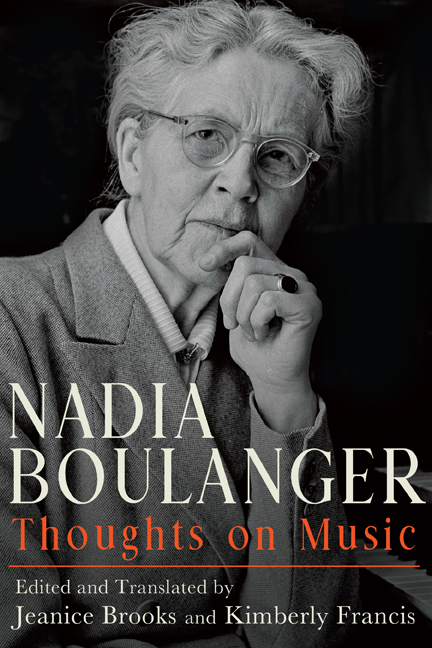Book contents
- Frontmatter
- Contents
- List of Illustrations
- Acknowledgments
- Editorial Apparatus and Critical Notes
- Note on Translations
- List of Abbreviations
- Timeline of Nadia Boulanger’s Life
- Introduction
- Part One Journalism, Criticism, Tributes
- Part Two Lectures, Classes, Broadcasts
- Bibliography of Nadia Boulanger’s Published Writing
- General Bibliography
- Index
“L’Oeuvre Théâtrale d’Albert Roussel,” La Revue Musicale 10, no. 6 (April 1929): 104–12, continued in 10, no. 7 (May 1929): 37–52 (complete text)
Published online by Cambridge University Press: 15 October 2020
- Frontmatter
- Contents
- List of Illustrations
- Acknowledgments
- Editorial Apparatus and Critical Notes
- Note on Translations
- List of Abbreviations
- Timeline of Nadia Boulanger’s Life
- Introduction
- Part One Journalism, Criticism, Tributes
- Part Two Lectures, Classes, Broadcasts
- Bibliography of Nadia Boulanger’s Published Writing
- General Bibliography
- Index
Summary
Albert Roussel's Theatrical Works
Albert Roussel is one of the most original artists of our times. Before engaging in a study of his theatrical works, this would seem a good opportunity to clarify the nature of his art as a whole.
This art sometimes comes across as difficult, and indeed it is. But what makes it so is the very nature of his thought and aural sensibility. Usual sonic combinations do not suffice to satisfy such sensibilities, to express such thoughts, and this artist has had to forge his own means of expression; has had to discover them, to discern them, because they already existed within him, it would seem. Albert Roussel came late to music, and if one dared, it could even be said that before understanding that this would be his true destiny, before having taken conscious notice of musical language, he already “contained” his music. While the majority of musicians learn to speak before they learn to think, he thought even before he began speaking, and somehow created the language of his aesthetic. From this, there emerge unexpected relationships that have appeared audacious or bizarre, but which for him were only obvious and natural. And if it is true, as Oscar Wilde says, that it is not the moment that makes the man, it is the man who makes the epoch, then the language of Albert Roussel is already classic.
For the musician, when you speak of feelings you speak of the relationship of sounds, vertical and horizontal, and the relationship of rhythms. Beginning with the earliest works of Albert Roussel, the harmonic aggregates, the melodic intervals, the rhythmic allure betray an independence that nothing can subdue. He accepts, he searches for the points of reference that establish tonality, he feels the necessity for cadential structures, but in his ingenious and tender hands—at times perhaps rough, but certainly strong— they transform themselves and become his, in a way that is undeniable. That is the mark of the masters. That there should be, among so many successes, some less effective experiments, was inevitable. But, quietly, in the mystery of a soul that knows itself, a body of work is being built that resembles nothing but itself, and that, in the process of being constructed, better marks both its variety and its unity.
- Type
- Chapter
- Information
- Nadia BoulangerThoughts on Music, pp. 208 - 232Publisher: Boydell & BrewerPrint publication year: 2020



